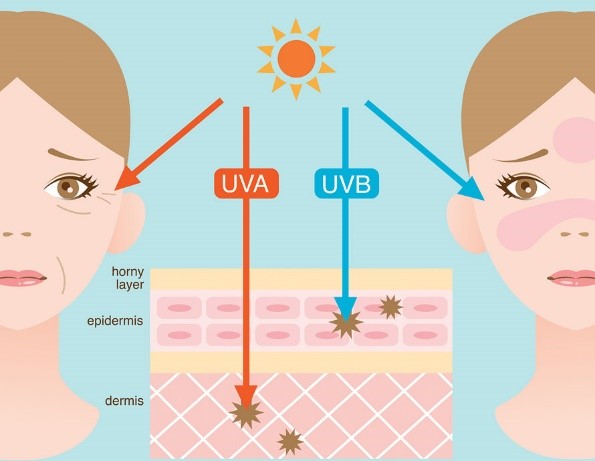Most of us will start to enjoy time outside in the sunshine as summer time approaches. There have been more inside days with the recent shelter in place orders, but it is always a good idea to review sunscreen basics. Hopefully, most patients and families are still getting outside daily for backyard play or walking/riding bikes (with properly fitting helmets). If you are not, please do! Practice good hand hygiene, social distancing and all the other rules, however we all need the sunshine to brighten our days.
Sun protective clothing, wide brim hats and ultraviolet (UV) protective sunglasses are a few important items that you need to consider when spending a duration of time in the sun. Most of us believe these are optional, but they are just as important as sunscreen. We should wear sunscreen daily, to regularly protect our skin and make it a habit for our children. Sunscreen should be applied on areas of the body not covered by UPF (ultraviolet protection factor) clothing. It is also recommended to use sunscreen to cover all parts of the face and head that are exposed, including those parts covered under wide-brimmed hats and sunglasses.
Did you know? “Even if it’s not sunny, 80% of UV rays still get through the haze. In addition, snow reflects 80% of the sun’s power” (Children’s Health 2020).
SPF, UVA/UVB protection and water resistant. All these acronyms, what do they mean?

SPF stands for sun protection factor. “The SPF number tells you how long the sun’s ultraviolet (UV) radiation would take to redden your skin when using the product exactly as directed versus the amount of time without any sunscreen. So ideally, with SPF 30 it would take you 30 times longer to burn than if you were not wearing sunscreen.” SPF protects you from the ultraviolet B (UVB) rays. Ideally, SPF means that if you get a sunburn after 10 minutes in the sun that you have 30 times more protection or 300 minutes (5 hours) of protection from the sun. BUT THIS IS WRONG due to multiple factors!
We often do not apply sunscreen correctly, decreasing its ability to work for that long. SPF also does not tell you the amount of time it takes for your skin to feel the effects of the UV radiation, PLEASE do not go out without sunscreen to experiment with this. Sun exposure varies depending on where you are located, time of day and skin type, so we never know how quickly we are getting TOO much sun. At minimum, sunscreen should be reapplied every 80 minutes (or 1 hour and 20 minutes). We should apply at least 1 ounce of sunscreen per person with every application or a thick visible layer, like frosting a cake (Dermatology Institute of America/DIA 2020). Give yourself a pat on the back if you apply sunscreen to yourself and children like this!
Ultraviolet Protection Factor (UPF) Clothing:
Why not WEAR sun protection, so that sun protection is easy and constant! SPF 30 blocks 97% of UVB rays, while SPF 50 blocks approximately 98% of UVB rays (Wang 2018). Most UPF fabrics/clothing are SPF 50+, which is better than most sunscreens (Cleveland Clinic 2019). A combo of UPF clothing (read the labels), wide brim hat, sunglasses and sunscreen is best!

UVA/UVB protection or Broad spectrum:
While SPF is important, it does not protect us from ultraviolet A (UVA) radiation. This is why it is important to purchase a sunscreen that is labeled broad spectrum, this means there is UVA protection as well. UVB radiation causes sunburns and skin cancer, while UVA radiation causes wrinkling and leathery skin changes (DIA 2020). Sunburns at any age increase the risk for skin cancer significantly.
Water resistance, NOT water proof:
There are three categories for water resistance with sunscreen: not water resistant, water resistant (40 minutes), very water resistant (80 minutes). In the US, sunscreen must be labeled if it is water resistant and for what duration. This means that you can sweat or be in a water activity for this amount of time before having to reapply. Sunscreen is no longer allowed to be labeled sweatproof or waterproof, as all sunscreen eventually washes off (FDA 2020).
Other important sun safety reminders:
The American Academy of Pediatrics recommends avoiding the use of sunscreen for infants under 6 months of age. Keeping young infants out of direct sunlight is best practice. Protective clothing, a wide brimmed hat and shade is a combination for success. It is important to avoid direct sunlight between 10am and 4pm on any given day as this is when ultraviolet radiation is the most intense. For older kids, it is not recommended to use tanning beds ever. If your family has a history of skin cancer, freckling or sun sensitive skin, your annual well child visit is a great time to ask questions. As a parent, tell your pediatric provider if you are concerned about certain skin moles or lesions. If you have any questions about sunscreen, sun safety……ask… you might just learn something new!
To health, wellness and sun safety,
Jennifer Ragusa PNP
References:
Wang, S. (2018, May). Ask the expert: does a high SPF protect skin better? Retrieved from https://www.skincancer.org/blog/ask-the-expert-does-a-high-spf-protect-my-skin-better/
https://dermatologyinstituteofamerica.com/ultraviolet-light-and-sunscreens/ (DIA 2020)
https://www.ewg.org/sunsafety/tips-sun-clothing.php
https://health.clevelandclinic.org/does-sun-protection-clothing-actually-work/ (Cleveland Clinic 2019)
https://www.childrens.com/health-wellness/facts-about-summer-sun-safety
https://kidshealth.org/en/parents/sunscreen.html
https://www.healthychildren.org/English/safety-prevention/at-play/Pages/Sun-Safety.aspx
